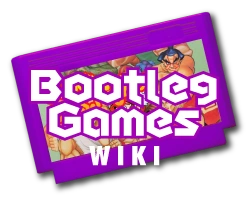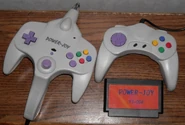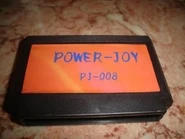Bigsmallboy (talk | contribs) |
No edit summary |
||
| (31 intermediate revisions by 13 users not shown) | |||
| Line 1: | Line 1: | ||
| + | {{Infobox console |
||
| ⚫ | |||
| + | |name = Power Joy Classic TV Game |
||
| ⚫ | The Power Joy Classic TV Game console |
||
| ⚫ | |||
| + | |imagewidth = 250px |
||
| + | |caption = Power Joy Classic TV Game. |
||
| + | |date = 2001 |
||
| + | |manufacturer = [[Trump Grand Manufacturing Co.|Trump Grand]] |
||
| + | |system = [[Famiclone]] |
||
| + | |games = 10 (built-in), 84 (PJ-008 cart), 64 (PJ-001 cart) |
||
| + | |developer = Nintendo |
||
| + | |alt = ''Power Joy''<br>''Power Joy II'' |
||
| + | }} |
||
| ⚫ | The '''Power Joy Classic TV Game''' console (commonly known as the '''Power Joy''') is an unauthorized [[famiclone]] manufactured by [[Trump Grand Manufacturing Co.|Trump Grand]]. It was sold in the UK and North America. The system resembles a Nintendo 64 controller, and the second player's controller shares many similarities with a PlayStation controller. It is the predecessor of the infamous ''[[Power Player Super Joy III]]''. |
||
| + | The console was first known to be sold in 2001,<ref>[http://web.archive.org/web/20010923010958/http://www.power-joy.com/ Power Joy Official Site (Wayback Machine)]</ref>, but variants are still produced by Trump Grand to this day.<ref>[https://web.archive.org/web/20160108145256/http://detail.1688.com/offer/35694693759.html Power Joy - 1688 (Wayback Machine)]</ref> |
||
| ⚫ | |||
| − | Unlike the Power Player Super Joy III, which uses the later "NES on a chip" method, this console instead uses a Famicom cartridge. |
||
| ⚫ | |||
| + | The consoles came with a Famicom [[Multicarts|multicart]] and 10 built-in games, mostly graphical hacks of NES games utilizing the NES Zapper. |
||
| + | Two different versions of the cartridge exist, a "PJ-008" 84-in-1 version and a "PJ-001" 64-in-1 version. The version with the PJ-008 cartridge was marketed as the "Power Joy II", but the "II" never appeared on the packaging or the console itself. Most of the included games are pirated NES/Famicom games, and as usual for pirate cartridges, the company logos and copyright details were removed. |
||
| ⚫ | |||
| ⚫ | |||
| − | * Most have battery pack (4 AAs) not included. |
||
| − | * Has AC adapter (DC9V mA350 (Centre Negative). |
||
| ⚫ | |||
| ⚫ | |||
| ⚫ | |||
| + | The game selections on each cartridge are similar, although the PJ-001 contains some repeats. There are also two known variations of the PJ-008 cartridge with a slightly different selection of games despite the identical label and product number. |
||
| ⚫ | |||
| ⚫ | |||
| ⚫ | |||
| ⚫ | |||
| ⚫ | |||
| ⚫ | * |
||
| − | * Runs off either 9 volt (negative tip) DC power-adapter or four 1.5 volt (AA-size) batteries inserted into a box where the N64 memory card would be. |
||
| + | The console was first manufactured around 2001, and its UK distributors claimed over 1 million sold by 2004.<ref>[http://web.archive.org/web/20040603064938/http://www.yes661.com/prodDetail.asp?id=520 Power Joy 2 - Yes 661 (Wayback Machine)]</ref> However, the Power Player Super Joy III was much more ubiquitous in North America. |
||
| ⚫ | |||
| + | |||
| ⚫ | |||
| ⚫ | |||
| + | *Most have a battery pack. It takes 4 AA batteries, which are not packaged with the console. |
||
| + | *It comes with an AC adapter (center-negative DC9V mA350). |
||
| ⚫ | |||
| ⚫ | |||
| ⚫ | |||
| + | |||
| ⚫ | |||
| ⚫ | |||
| ⚫ | |||
| ⚫ | |||
| ⚫ | |||
| ⚫ | *Although the Power Joy's button layout is identical to that of the Nintendo 64 controller, the buttons have been mapped differently. The C buttons of the N64's controller function as A and B on the Power Joy, the A and B buttons of the N64's controller are Start and Select on the Power Joy, respectively. Finally, the N64 controller's Start button is the Reset button on the Power Joy. |
||
| + | *It can run off of a 9V battery (negative tip) or 4 AA cells. |
||
| + | |||
| + | == Successors == |
||
| + | A number of other consoles were released in the Power Joy line following the original unit. These include: |
||
| + | *Power Joy III aka Power Joy Crusader - featured an LCD "brick game" built into the controller |
||
| + | *Power Joy Supermax - similar to the original, but with built-in rumble and 90 original games included |
||
| + | *Power Joy Navigator - joystick-based with 50 original games, released in both wired and wireless versions |
||
| + | *Power Joy Solo |
||
| + | *Power Joy Turbo Racer |
||
| + | *Power Joy Streamline |
||
| + | *Power Joy Voyager |
||
| + | |||
| + | Trump Grand still uses the brand name "Power Joy" on many of its current products. |
||
| + | |||
| ⚫ | |||
<gallery> |
<gallery> |
||
| − | + | File:PowerJoyFamilyPhoto.jpg|The two controllers and a cartridge. |
|
| + | File:Pj-008.jpg|The Power Joy cartridge, with over 70 games. This is the PJ-008 version. |
||
</gallery> |
</gallery> |
||
| + | |||
| + | == References == |
||
| + | {{Reflist}} |
||
| + | [[Category:Famiclones]] |
||
| + | [[Category:TV game]] |
||
| + | [[Category:Hardware]] |
||
| + | [[Category:Consoles]] |
||
Revision as of 21:16, 2 May 2020
The Power Joy Classic TV Game console (commonly known as the Power Joy) is an unauthorized famiclone manufactured by Trump Grand. It was sold in the UK and North America. The system resembles a Nintendo 64 controller, and the second player's controller shares many similarities with a PlayStation controller. It is the predecessor of the infamous Power Player Super Joy III.
The console was first known to be sold in 2001,[1], but variants are still produced by Trump Grand to this day.[2]
Background
The consoles came with a Famicom multicart and 10 built-in games, mostly graphical hacks of NES games utilizing the NES Zapper.
Two different versions of the cartridge exist, a "PJ-008" 84-in-1 version and a "PJ-001" 64-in-1 version. The version with the PJ-008 cartridge was marketed as the "Power Joy II", but the "II" never appeared on the packaging or the console itself. Most of the included games are pirated NES/Famicom games, and as usual for pirate cartridges, the company logos and copyright details were removed.
The game selections on each cartridge are similar, although the PJ-001 contains some repeats. There are also two known variations of the PJ-008 cartridge with a slightly different selection of games despite the identical label and product number.
The console was first manufactured around 2001, and its UK distributors claimed over 1 million sold by 2004.[3] However, the Power Player Super Joy III was much more ubiquitous in North America.
Technical aspects
- The player 1 controller features a cartridge slot that supports most cartridges designed for the Famicom.
- Most have a battery pack. It takes 4 AA batteries, which are not packaged with the console.
- It comes with an AC adapter (center-negative DC9V mA350).
- It has composite and audio outputs.
- It is able to run unlicensed NES/Famicom games.
- It only comes in one color (white).
Unit aspects
- The player 1 controller resembles a Nintendo 64 controller with a cartridge slot for most Famicom games.
- It comes packaged with a second controller. It has a similar button layout to a standard Playstation controller.
- The first controller has a light gun built into it. The trigger is the shoot button.
- Unlike its successor, the joystick on the first controller is functional.
- Although the Power Joy's button layout is identical to that of the Nintendo 64 controller, the buttons have been mapped differently. The C buttons of the N64's controller function as A and B on the Power Joy, the A and B buttons of the N64's controller are Start and Select on the Power Joy, respectively. Finally, the N64 controller's Start button is the Reset button on the Power Joy.
- It can run off of a 9V battery (negative tip) or 4 AA cells.
Successors
A number of other consoles were released in the Power Joy line following the original unit. These include:
- Power Joy III aka Power Joy Crusader - featured an LCD "brick game" built into the controller
- Power Joy Supermax - similar to the original, but with built-in rumble and 90 original games included
- Power Joy Navigator - joystick-based with 50 original games, released in both wired and wireless versions
- Power Joy Solo
- Power Joy Turbo Racer
- Power Joy Streamline
- Power Joy Voyager
Trump Grand still uses the brand name "Power Joy" on many of its current products.


